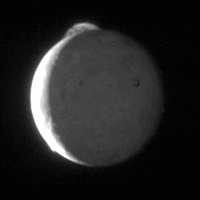Pillan Patera

Pillan Patera is a patera, or a complex crater with scalloped edges, on Jupiter's moon Io. It is located at 12°20′S 243°15′W / 12.34°S 243.25°W, south of and west of Reiden Patera. It is named after the Araucanian thunder, fire, and volcano god. Its name was approved by the International Astronomical Union in 1997.[1]
Pillan Patera is approximately 70 kilometers in diameter.[1] In the summer of 1997, it erupted in an event now defined as "Pillanian" eruption style. At temperatures higher than 1,600 °C, (2912 °F) a 140 kilometer high plume eruption deposited dark pyroclastic materials rich in orthopyroxene over an area greater than 125,000 km2. This was followed by the emplacement of over 3,100 km2 in dark flow-like material north of the caldera. The high temperature part of the eruption lasted from 52 to 167 days and between May and September 1997, with peak eruption temperatures around June 28, 1997.[2]
The 1997 eruption was the largest effusive eruption ever witnessed. During a 100-day period, at least 31 km3 of lava were erupted, with 25 km3 shortly afterward. The eruption sheds light on emplacement of very large, voluminous flows millions of years ago on Mars and Earth. The highest effusion rates exceeded 10,000 cubic meters per second.[3] The eruption produced a large, dark, deposit, 400 kilometers in diameter, which surrounds Pillan and partially covers a bright red ring left by the volcano Pele's plume. Since the eruption, the Pillan plume deposit has faded, coated by material from Pele and Kami-Nari Patera, a small volcano to the east of Pillan Patera.[4]
References[]
- ^ a b "Pillan Patera". Gazetteer of Planetary Nomenclature. Retrieved February 21, 2018.
- ^ Williams, David A.; Davies, Ashley G.; Keszthelyi, Laszlo P.; Greeley, Ronald (2001). "The summer 1997 eruption at Pillan Patera on Io: Implications for ultrabasic lava flow emplacement". Journal of Geophysical Research: Planets. 106 (E12): 33105–33119. Bibcode:2001JGR...10633105W. doi:10.1029/2000JE001339.
- ^ Davies, Ashley; Keszthelyi, L.; Wilson, L. (2006). "The Biggest Eruption Ever Witnessed: The Effusion Profile of the Pillan (Io) 1997 Eruption, and the Implications for Massive Basaltic Flow Emplacement on Earth and Mars". American Astronomical Society, DPS Meeting #38, #30.03; Bulletin of the American Astronomical Society, Vol. 38, P.538. 38: 30.03. Bibcode:2006DPS....38.3003D.
- ^ "Galileo Images of Pillan Patera". pirlwww.lpl.arizona.edu. Archived from the original on May 17, 2003. Retrieved October 20, 2007.
- Volcanoes of Io (moon)
- Active volcanoes
 WikiMiniAtlas
WikiMiniAtlas

